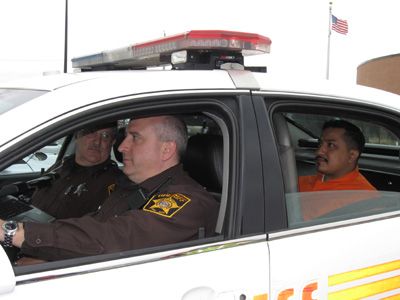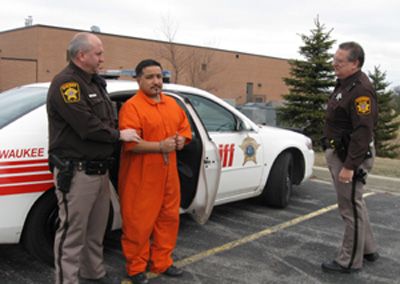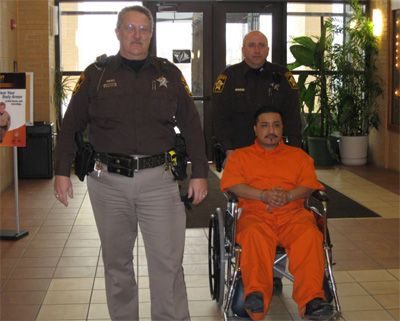Contact/cover for prisoner transportation
Prisoner transportation is a very dangerous assignment. Yet, we do these transports so often, complacency sets in, and we get ourselves hurt or killed — even in the presence of other officers. To keep us as safe as possible, let’s examine how to use the time-tested contact/cover concept.
|
The basic concept is deceptively simple: When you have two officers, one acts as the contact officer who maintains contact with the prisoner while the second officer, the cover officer, provides cover and security for the first. This may seem pretty simple in theory, but can be complicated and difficult in application.
Andy Casavant, a national known defensive tactics and officer safety instructor from the Walton County (FL) Sheriff’s Office, recently wrote an excellent article on this topic for PoliceOne called Cover officer: Person or position?
Although this article is directed to street officers making vehicular traffic stops, his message contains many important carryovers to prisoner transportation; after all, prisoner transportation requires that you take prisoners in and out of vehicles on public roadways.
Here is the important concept that Andy Casavant develops: The cover officer is a position, not a person. Put another way, you may not have a second officer available, so you’ll need to cover yourself. This means you need to provide your own cover functions: You need to watch the prisoner and scan for outside threats while driving to your destination.
 Cover officer actively watches prisoner in rear seat of a cage squad. (Photo/Dep. Beth Miers) |
This is difficult to do, which is why prisoner transportation is best accomplished by two or more officers who know their function and vigilantly cover your back. As many officers have found out to their and their fellow officer detriment, a cover officer who in not fulfilling his/her function is useless — and a safety hazard to everyone. Two officers are better than one, but only when they function as a team. When this team of officers is on the top of its game, it’s hard to beat.
 Contact officer still keeps an eye on the prisoner in the rearview mirror. (Photo/Deputy Beth Miers) |
In past Corrections1 articles, we’ve talked extensively about best practices for transporting prisoners. Among these were general discussions of prisoner transportation procedures designed as a checklist for doing the job right. Here, we’ll examine the application of contact/cover principles to prisoner transportation.
The most important thing to remember is that both officers have to keep their heads in the game, stay focused and pay attention to the prisoner and to each other.
In the tactical communication training that I provide for Dr. George Thompson of the Verbal Judo Institute, we discuss the caring watch concept, that is, how best to monitor your fellow officers to make sure that they’re doing their jobs properly. This isn’t a Big Brother thing; watching out for your fellow officer keeps everyone safe. Every officer has good days and bad days, days when they’re up, days when they’re down, feel great or feel sick. By watching how every one of us performs, we are truly “watching each other’s back.”
What are you watching for? Well, for starters, watch to make sure the contact/cover positions are being properly handled. Otherwise you may need to become a S.O.S. / N.B.A. even though there are two officers present. The important thing is that you keep yourself and your partner safe.
There are many components of a successful prisoner transportation that use contact/cover. They include, but are not limited to:
- Picking Up: Inmate / vehicle
- Moving to the vehicle
- Entering the vehicle
- Monitoring the prisoner while driving to the destination
- Arriving at the destination
- Leaving the vehicle
- Entering the building / internal transportation
- Taking care of business / logistical needs
- Leaving the building
- Returning to the vehicle
- Entering the vehicle
- Monitoring the prisoner while driving back
- Leaving the vehicle
- Turning over the prisoner
 Every time the prisoner is put in or taken out of the squad, physical contact/cover is utilized. (Photo/Dep. Beth Miers) |
Let’s look at one of the most violated applications of the contact/cover principle: Putting a prisoner into — and taking a prisoner out of — a vehicle. How may times have you either participated in or observed a prisoner being removed from a vehicle by one officer while the driver of the vehicle sits behind the wheel and watches — or worse, doesn’t watch the process? This is one of the most dangerous times in prisoner transportation. This is when escapes attempts often occur, and where both officers are needed to keep everyone safe.
Once that door is open, both officers need to be on the top of their game, ready to deal with whatever happens. The same is true when you put the prisoner back in the prisoner compartment. This is not the time to play catch-up, or to realize too late that bad things are happening. Whether you are an SOS /NBA or a two officer squad, apply the cover position to keep things safe.
About the author
Gary has been involved for over fifteen years in the development of both training & duty trauma protective equipment. He is currently employed by PoliceOne.com as a Use-of-Force subject matter expert, researcher, program developer, and training specialist where he continues to provide tactical communication skills and defensive tactics training. His collaboration with the Force Science Research Center, Team One Network, Northeast Wisconsin Technical College, Verbal Judo Institute, and Purposeful Development Associates allows him to bring the most current tactical and instructional insights into his training programs. He is the lead instructor for Verbal Judo’s Tactical Communication for the Correctional Professional training program.
Our thanks to the Milwaukee County Sheriff’s Department Training Academy for supporting the development of the photographs for this article. Deputy Beth Miers took the photos and Deputies Juan Avila, Brent Smoot, and Gregory Zimmer were the featured talent.













